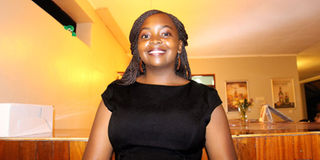Student innovation to ease movement of PWDs

Voice controlled wheelchairs are not a new phenomenon. However, what makes Nalujjumwa’s innovation stand out is the fact that the voice commands are in a local language which is familiar to many people. File Photo
She first saw her grandmother experiencing strokes as a young girl of 13. She vividly remembers how they eventually had to push her around in a wheelchair after several strokes deprived her of most of her motor abilities.
Innovation
Years after, a young lady of 21, when Gloria Nalujjumwa, was given an opportunity to come up with an innovation for her final year project, while pursuing her diploma in Computing at Uganda Technology and Management University (Utamu), she couldn’t think beyond a wheelchair that can be vocally controlled in the local dialect [Luganda].
She then put the skills she had learned in class into the thought to build a prototype of a control unit, which took her and her colleague three months.
“We built a control unit that can just be mounted onto the wheelchair. The user can thereafter just issue vocal commands in luganda to which the wheelchair operates,” Nalujjumwa explains.
Since the goal was to also give traditional/ manual wheelchairs some level of automation, the control unit also consists of motors which are able to drive and steer the wheels on the wheelchair instead of someone pushing the wheelchair themselves.
Nalujjumwa further notes that though motorised wheelchairs are more ideal and compatible with the innovation, majority of Persons With Disabilities (PWDs), in Uganda use the manual wheelchair and thus they had to put that into consideration.

A control unit that can just be mounted onto the wheelchair was built. Net Photo
For voice commands to move the wheelchair, the device uses syllables which include: Maaso (front), Mabega (back), Ku kkono (Left), Ku dyo (Right) and Sitopu (Stop).
“We choose to use ‘Sitopu’ because ‘Komaawo’ wasn’t working well with the coding. Once the user inputs these words into the microphone, the wheelchair will move accordingly. So, we have two programs; the speech programme and the one that controls the motors for movement,” Nalujjumwa adds.
A partnership
However, Nalujjumwa didn’t work alone. As a prerequisite for her project, she worked with her partner Jonathan Nyanga. While working on the innovation, the two would brainstorm ideas after which, Nyanga would work on building the hardware and Nalujjumwa the software and the coding to have the prototype.
“The biggest challenge has and still is the failure to get some of the right components in time, for example the specific microphones we want to use. We had to order for it outside Uganda because as far as we looked, we didn’t get it,” says Nyanga.
Easing access
Commenting on the innovation, Mpindi Bumali the chairman National Union of Disabled Persons in Uganda (NUDIPU) says that the innovation is definitely a step in the right direction when it comes to employing technology in PWDs, especially if it is cheaper and affordable because PWDs struggle with access.
“If you have a device on a wheelchair you can just command to climb a hill in the local language, that is a good thing. The only challenge and concern is, motorised wheelchairs are very expensive and can only be afforded by a few people,” Bumali said.
Robert Tumusiime a lecturer at Utamu and the supervisor of the innovation says that with this kind of innovation and technology, PWDs will be able to use technology to access services.
Allan Nyesiga the head of the department of Computer Science and Engineering at UTAMU is proud that lately, students have started to learn and to understand what innovations are, and the reason why they need to innovate.
The two partners currently have a prototype in place, which they hope to improve with time, before they can finally release a final product into the market.
“Our biggest huddle thus far are funds to improve the innovation. Otherwise, I am confident that here is a lot we can do with it, to ease access of PWDs,” she concludes.
Voice controlled wheelchairs are not a new phenomenon. However, what makes Nalujjumwa’s innovation stand out is the fact that the voice commands are in a local language which is familiar to many people. Additionally, the ability of the innovation to bring some automation to the ordinary manual wheel chair cannot be undermined.
About Nalujjumwa
She finished her primary education at Victorious Education Services. She then did her O -Level at Seeta High School, main campus before joining St. Lawrence Schools and Academy for her A Level education. She thereafter joined UTAMU to pursue a diploma in Computing and graduated in 2019.
Nalujjumwa is passionate about employing technology to enhance access for People with Disabilities in Uganda, starting with her innovation.



